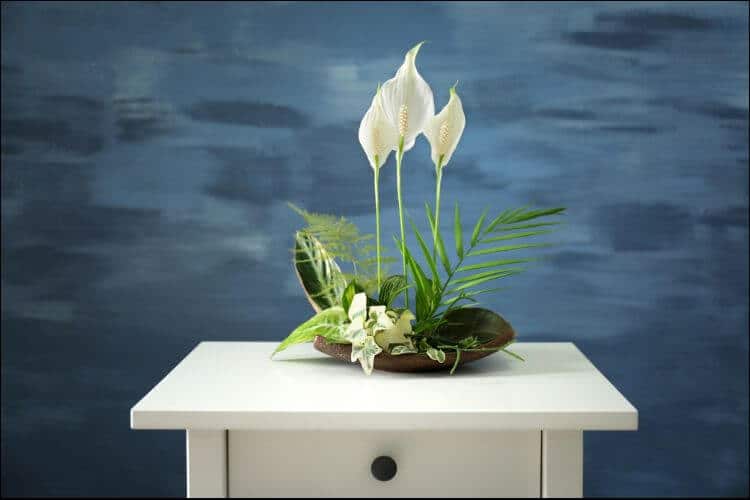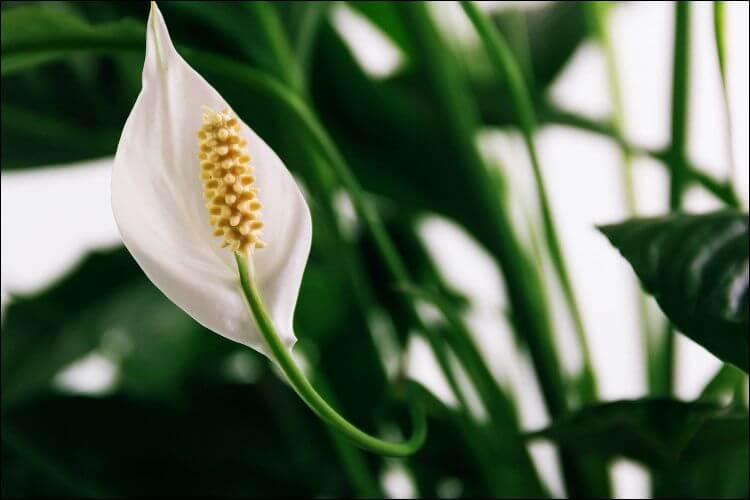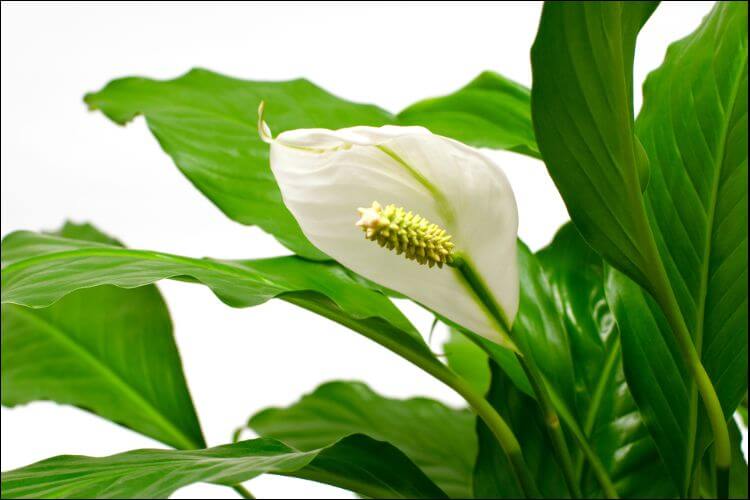Peace lilies are one of the most popular houseplants. They are very easy to grow, and they usually grow between 16 inches and 6 feet tall. The tropical plant can also help you with purifying the air, since it breaks down and neutralizes toxic gases (such as formaldehyde and carbon monoxide). Today we are going to learn how to care for a peace lily indoors in some simple steps.
Our Favorite Peace Lilies;
No products found.
How to Care for a Peace Lily Indoors 101
1. Choose a Good Spot
If you’re already familiar with planting lily of the valley in your garden, for instance, then you know how important location is when deciding to grow a lily. The same thing goes when you’re trying to learn how to care for a peace lily indoors as well. What you need to keep in mind is the fact that peace lilies are native to the tropical rainforests, which means they love a hot, moist, and shady environment. For this reason, you can’t leave it outside if you live in a temperate environment.
When keeping it inside, place it close to a window (but not directly under it). A good idea is to choose a window tat faces north or west since they don’t let direct sunlight to shine upon the plant all day. It’s important not to expose the plant to cold air or to give it too much sun. These two are the two main causes for which the plant turns brown and its leaves get shriveled.
2. Water It Adequately
Knowing how to care for a peace lily indoors also consists of watering it adequately. It’s important to do it only when the potted soil is dry. Then, add plenty of water until it’s damp. However, make sure you don’t overdo it. There shouldn’t be any standing water around the plant. If you give the plant too much water, it will wilt and die, not to mention that it can cause root rot.
On the other hand, if you neglect this aspect, your peace lily will visibly droop. The ideal watering schedule is once a week when you notice the soil dried. Some gardeners think it’s better to wait even until the plant starts to slightly wilt until you water again.
3. Mist the Leaves
Another essential thing to remember is to mist the leaves. Use a spray bottle and repeat this step several times a week. Remember that peace lilies love the high humidity levels since they natively grow in the tropics, which is why you need to do this. In this way, you help replicate the humid air that exists in the rainforest. During the summer growing season, you need to offer it even more water. The more you can supply them, the better it is.
Be careful, since the peace lily is extremely sensitive to chlorine. Because of this, it’s important to use dechlorinated water. If you can’t find it for sale, you can make your own: leave tap water at room temperature for 24 hours.
4. Ensure the Right Temperature
Ideally, peace lilies love a consistent temperature that stays between 65 and 80 degrees F. It’s important to protect the plant from a drastic change when it comes to temperature. Make sure there is no draft around it either.
5. Trim the Leaves
If you think about other plants, you’ll see that peace lilies don’t need frequent pruning. Even so, if you see that one of the limbs and leaves of the lily start getting wilted or brown, you may need to prune the leaves. In this way, your plant will not waste any more energy on the dying parts.
Take a clean pair of scissors or pruning shears and take off any dead or unhealthy spots. It’s important for the cuts to be clean and near the soil level. Make sure you’re not damaging the healthy tissue.
6. Fertilize the Plant
Besides water and sunlight, you don’t need to worry too much about how to care for a peace lily indoors. Fertilizing is not necessary if you want to grow a healthy plant, and so are the nutrient supplements. However, if you still want to use fertilizers to boost the peace lily, it’s important not to overdo it. Once a month, in spring and summer, you should use the standard 20-20-20 houseplant fertilizer.
Make sure you use it at ½ or ¼ of its strength and do this when the plant growth is the most active. If you notice any green blooms, you should know that these are a sign of over-fertilization. In this case, stop any fertilizing process and cut the dose in half the next growing season.
7. Repot the Plant
Just like any plant that grows in a pot, peace lilies will grow too big for the original container. You can tell if this is happening because the plant seems to need more and more water, or its leaves become yellow. Sometimes, you can even see the roots getting to the surface of the soil. In general, peace lilies require some repotting every couple of years. Keep this in mind, and if you notice the symptoms above happening, start the repotting process.
8. Keep Away from Children and Pets
This is perhaps the most important part of learning how to care for a peace lily indoors. Get used to keeping the plant away from children and pets. All the components of the plant contain calcium oxalate, which is an irritant and a toxin at the same time. Wash your hands after you handle the plant since it produces crystals that irritate your skin. Moreover, make sure you don’t touch your eyes after you handled it!
9. Deal with Root Rot
Root rot is a peace lily problem that might appear more often than you’d want to. It’s a serious condition that affects a lot of plants under the surface and it even kills them sometimes. This appears when a plant has poor drainage or is over-watered. If the roots are standing in water for a longer period, it gets hard for them to get the oxygen they need to develop correctly. For this reason, they will start rotting.
There are also other types of microorganisms, called water molds, which help the rot spread around. If the moisture conditions are met, they can even spread root rot to other plants. If you notice your peace lily is suffering from this, remove it from its pot. Next, cut off the slimy, dead, or rotten parts of the root. Then, plant the lily in a new pot, where you need to place dry soil and ensure a good drainage.
10. Get Rid of Pests
If you want to learn how to care for a peace lily indoors correctly, you need to know how to fight pests as well. The most common ones you will find are mites, aphids, or small arthropods. Usually, if your plant suffers from this, the leaves start to wilt and die.
Most of the time, these signs come together with visible pests, white webbing, or a slimy and sticky discharge. In this case, with the help of a strong stream of water, you can blast the pests off the plant. Next, to ensure they won’t come back, use an insecticide that is safe for plants.
11. Get Rid of Fungus
Another problem you may stumble upon when learning how to care for a peace lily indoors is a fungus infection. They can be either harmless or fatal, so you need to pay attention to them. The clearest sign that your plant is going through something like this is that it has a fuzzy growth on the soil, in a white or grey color. If you are susceptible to allergies, you may be irritated by the weird growth.
A good way of solving this problem is to sprinkle cinnamon on the fungus. It may sound weird, but cinnamon has anti-fungal properties. However, if you notice that the lily itself has a dark coating on the leaves or the stalk, things may be serious. First, you need to make sure that the coating isn’t caused by frost damage or any other reason.
In the case the fungal infection is serious, you should simply discard the entire plant. It may seem like a drastic measure, but keep in mind that fungal spores are very persistent. They can stay in the soil and the area around the plant for quite a while, then re-infect other plants as well.
Here you have a brief clip explaining in detail how to care for a peace lily indoors:
Conclusion
Learning how to care for a peace lily indoors isn’t a difficult process. What you need to keep in mind is that this plant has special needs when it comes to light, water, and temperature. It’s useful to be aware of the possible pests and diseases as well and to keep an eye on the symptoms.
However, if it happens for your plant to suffer from a fungal infection, pests, or root rot, there are some ways in which you can try to get rid of them. Even so, there might be cases where it’s too serious and you’ll need to discard the plant altogether.
Images source: depositphotos.com
Last update on 2024-04-19 at 16:20 / Affiliate links / Images from Amazon Product Advertising API













The leaves on my peace Lily is turning black. What to do.
Thank you, I have lily that is not growing I try some of your tips.
thanks, I now know I have been overwatering my plant and I believe we have it in a poor location will correct this at once thanks andy
That may be caused by a bacterial spot. The symptoms that your peach my experience are tiny, purple, black, or brown lesions that appear on leaf tips and then migrate to the leaves’ center. To counterattack, use a copper-based fungicide on your peach tree’s leaves when they begin to fall
Thank you for all the info/
Hi, Kathleen Nepia! Great! Did your lily grow healthy with this growing guide? Share a photo of your peace lilies indoors so we can see how beautiful they are.
Some of my flower tips turned brown. What does that mean? Am I over watering?
Hi, Cleo! There are many reasons why flower tips turn brown. First, if brown tips and brown spots occur, it indicates that the plant is not receiving proper care in terms of its basic needs, such as sunlight, water, soil mix, and temperature. Second, peace lily flowers turn brown naturally when they reach the end of their life cycle. It’s completely normal, and not something you should worry about if your plant is otherwise healthy. But recall the care you gave your peace lily so that you can identify the problem. Enjoy growing with your plants!